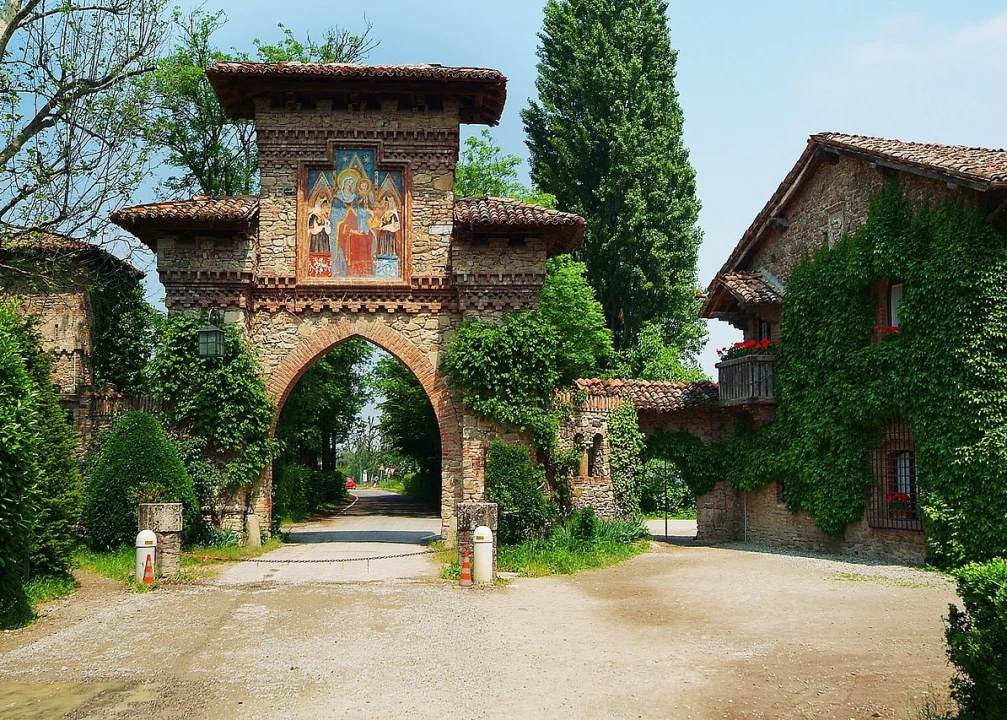Grazzano Visconti is a medieval style village in the municipality of Vigolzone, in Val Nure, in the Piacenza area, Emilia Romagna. The heart of the village, private but open to the public, is the ancient castle, which dates back to 1395. It is surrounded by a large park of 15 hectares, built in the same period by Giuseppe Visconti, rich in ancient trees, hundreds of roses and hydrangeas, marble statues, fountains and small ditches, controlled by gates ruled by hand. Among the most important elements we can find the belvedere overlooking the Grazzano stream, decorated with a marble statue depicting the god Apollo, a labyrinth, an Italian garden, a baroque basin at the back of the castle.
The place appears in documents dated to the year one thousand, but it was the Visconti, lords of Milan, who built the castle in 1395, in honor of the wedding of Beatrice Visconti, sister of Gian Galeazzo Duke of Milan, with Giovanni Anguissola, belonging to one of the most important families of Piacenza. The complex was built on a square plan with four towers at the corners and, inside, a courtyard surrounded by arcades.
The property remained in the hands of the Anguissola family until 1884, when it passed into the hands of the Visconti di Modrone counts. It was Giuseppe Visconti di Modrone who had the new village of Grazzano built, transforming the ruined farmhouses into medieval-style accommodation, to make it a school of local craftsmanship of wrought iron and wood carving, an activity that is still alive today. In addition to the castle, the village includes buildings of great charm, including the churches, the Palace of the Instituttions, the mill, fountains, and the Hotel of the Biscione, on which stands the symbol of the family: a large red carnation with an inscription that, read in reverse (in honor of Leonardo da Vinci) says: "Impipatene e guarda in alto” (Don’t’ bother and and look up).
Together with the park, Count Giuseppe Visconti di Modrone had the castle and the large park that surrounds it restored. Today, the latter appears in an eclectic style, with traits of the Italian garden and the English landscape garden: rich in tree species, some of which are very ancient, formal hedges, geometric flowerbeds, topiary forms and sinuous paths. It is divided into an area dedicated to the formal garden, characterized by two large parterres enclosed by chains covered with ivy (Hedera helix), adorned with statues of the Four Seasons, the Fountain of Orpheus, and large topiary forms.
In front of and to the sides extends the English park, crossed by paths shaded by yews (Taxus baccata ), poplars and lindens, and three important avenues, including, smaller than the central one, one of bagolari (Celtis australis) and one of plane trees (Populus x hybrida). In addition to yews, there are many other evergreens, such as cypresses (Cupressus sempervirens spp.), pines, holm oaks (Quercus ilex), myrtle (Myrtus communis ) and boxwood (Buxus semprevirens) shrubs. There are also native species such as oak (Quercus robur), elms, black poplars (Populus nigra), hazelnuts (Corylus avellana), field maples (Acer campester), cherry (Prunus avium), hornbeams and ash trees, as well as shrubs in the undergrowth such as black pudding (Cornus sanguinea) and privet (Ligustrum vulgaris), and many roses and hydrangeas. Among the centuries-old trees, there is a plane tree over 150 years old, an 80-year-old lime tree and a splendid group of Lebanese cedars (Cedrus Lebani).
Behind the castle, on the east side, there is a neo-Baroque fishpond, decorated with vases and allegorical statues. From here starts a long hornbeam, then after the final part from privet plants. To the north of the shady path, you reach a lookout point overlooking the countryside. To the west of the fishpond there is a small medieval-style cottage, the charming little house built for the children of Count Giuseppe, and you enter a small polygonal boxwood labyrinth. In the park there is also a swimming pool of the early twentieth century, adorned with a statue of neptune.
The park is irrigated by the Grazzano stream, through a complex water system, with canals, small ditches and shutters.




